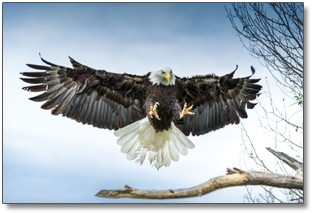Bald Eagles Return to Pennsylvania
By Samba Lampich
After more than 250 years of absence, the bald eagle has returned to nest along Pittsburgh’s three rivers. The majestic bird of prey was nearly extinct, but thanks to an aggressive protection program, their numbers are on the rise.
Industrialization as a Culprit
Booming industrialization in the 19th century led to large-scale deforestation and destruction of mature trees that were home to the bald eagles. Pollution from growing industries and use of the pesticide DDT destroyed rivers and the fish that were the main source of food for the birds. All these factors — a lack of nesting trees, decline of food and the use of DDT — lead to the near-extinction of the birds.
Long Flight from Home
By the 1980s, there were just three pairs of eagles’ nests in the northwest region of Pennsylvania. In June of 1983, the Pennsylvania Game Commission launched the Bald Eagle Restoration Project. A group of Game Commission employees, traveled to Laronge, Saskatchewan, to capture young bald eagles and bring them back to Pennsylvania. They would take seven such trips. At that time, the Saskatchewan province had a stable bald eagle population.

Photo Credit: Christopher Barnatt 2011
A Brighter Future
According to the Pennsylvania Game Commission, by 1999, 42 active nests produced 47 eaglets and by 2010 they had produced at least 293. By 2012, there were more than 200 bald eagle nesting locations in Pennsylvania. Efforts to clean up Pennsylvania’s rivers have been successful and there are pairs of nesting bald eagles along each of Allegheny County’s three rivers; the Monongahela, Allegheny and Ohio.
The bald eagle remains threatened in Pennsylvania and continues to be protected under state and federal laws.
Bald Eagle Facts
- Bald eagles build the largest nests of any North American bird and can be found nowhere else in the world
- A pair of bald eagles generally mate for life
- The bald eagle wingspan ranges from five and a half to eight feet
- An eagle may weigh eight to 12 pounds and the females are about 25% larger
- Both male and female will sit on the nest to protect the eggs and young, and will take turns foraging for food
Classroom Discussion
- What are some etiquette rules that should be followed when observing endangered species like the bald eagle?
- How have some of the federal and local laws helped with the restoration of endangered species? Think about the Clean Water Act and others.